You can see the splendour of Antigua’s glorious past in the intricate ornamentation of its restored Baroque-style temples. You can feel it in the eerie ruins, holding their pieces together to wonder you with their magnificence, despite the cracks and the deep scars left by powerful earthquakes.
Today, the splendor of Antigua -a small city in South-central Guatemala surrounded by volcanos and a UNESCO World Heritage Site- is still alive and kicking thanks to the preservation of its colonial architecture.
Wandering through its cobblestone streets felt like a treasure hunt that filled my bag with images of beautiful churches and former convents and the taste of delicious food. I also had to make space for images of the imposing volcanoes and the bright colours and the art. And for the kindness of the people.
During your stay you can take exciting day trips from Antigua and hike volcanoes, visit lovely small towns, go for birding tours, or head to the coast for a total change of scenery and go to the beach.
This is one of those places that make you think Hmmm… yeah, I could live here…
Read more below to find out why.
Disclosure: This post contains some affiliate links. If you make a purchase through those links I will earn a commission at no additional cost to you (zero, nada). To check the full disclaimer, click here.
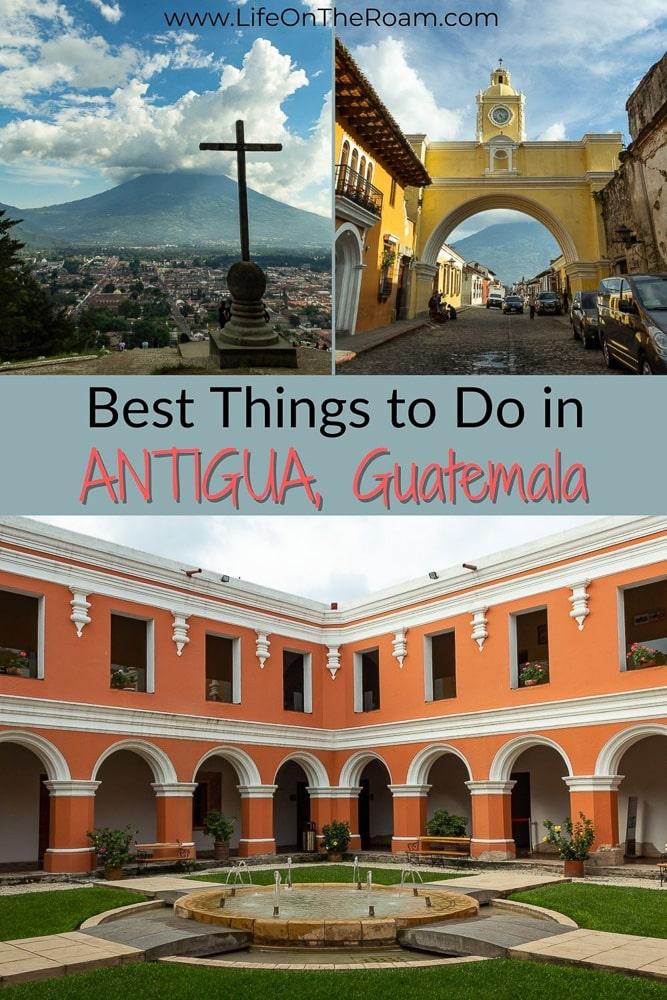
Table of Contents
A Brief History of Antigua, the Former Capital of Guatemala
Of all the disasters a town could go through, Antigua checked off almost every box.
The Spaniards planted their flag in 1524 naming the place Santiago de Los Caballeros de Guatemala, and the indigenous population wasn’t happy with the invasion.
Their way to say they weren’t happy was to set the place on fire.
Three years later people returned and everything they built up to 1541 ended up buried under a mudslide courtesy of Volcano Agua.
The following year people said Let’s give this another try.
For a bit over 200 years, they had a break from disasters and the city became the capital of the Kingdom of Guatemala. A cool place where all major events in politics, religion, and arts happened, with stately Baroque-style buildings to match.
But after the (sort of) two-centuries-drama-free period (they still had to battle volcanic eruptions and floods) an earthquake flattened the city in 1773. At this point whoever was running the government said That’s it, we’re out of here!, and moved the capital to what it’s today Guatemala City.
People started referring to the former capital as La Antigua Guatemala (the Old Guatemala), which is why some people call it La Antigua.
No construction was allowed for several decades which helped preserve the original grid pattern and the ruins. The area was repopulated thanks to the rise of the coffee plantations, which also kickstarted the restoration of some buildings.
These are the best attractions in Antigua Guatemala
Take Your Picture at the Arch of Santa Catalina
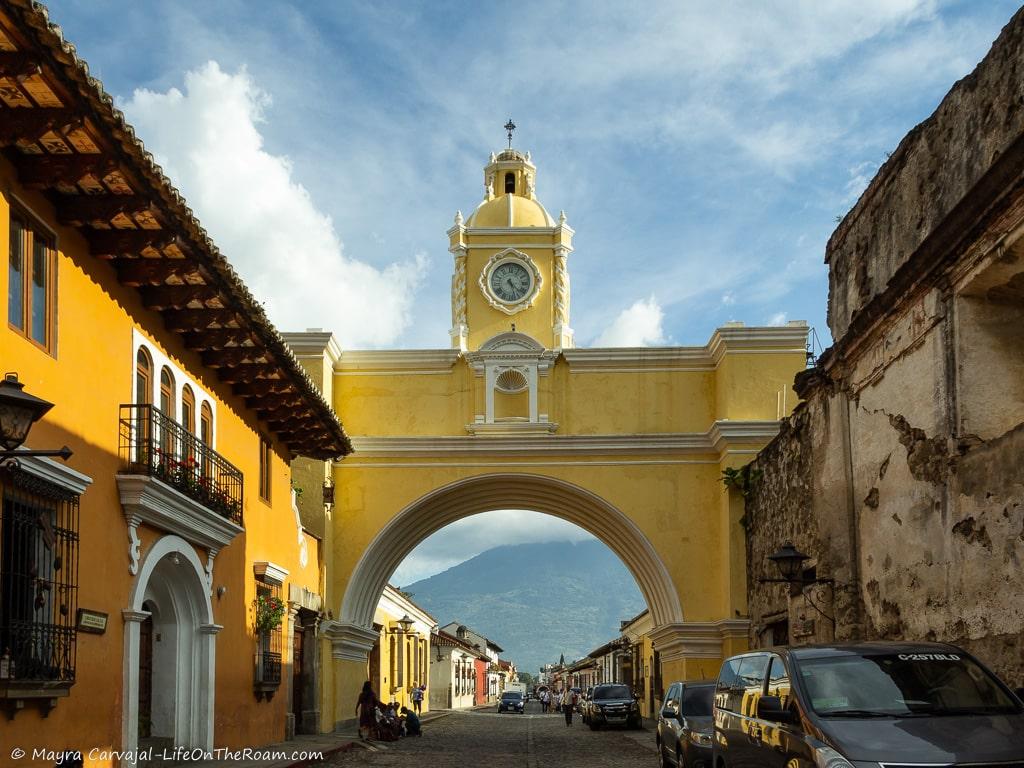
The Arch of Santa Catalina is such a landmark of the city that you’ll see it in nearly every Antigua-related article.
Why the name? In the 17th century, on one side of this same street, there was a school and on the other side, there was a convent. The nuns who lived in that convent taught in that school, but they didn’t want to be seen by the public when they crossed the street so they built an arch named it after the convent: Santa Catalina. The clock was added almost two centuries later.
5a Ave.Norte, south of 1a Calle Poniente
Visit Caoba Farms
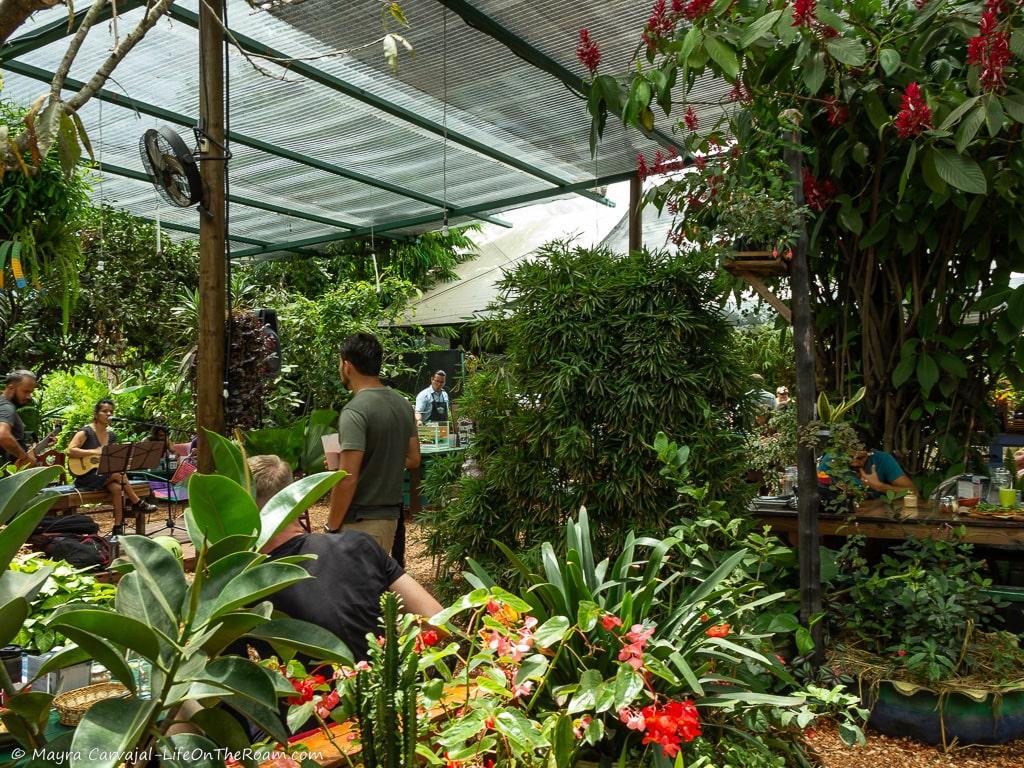
The best time to visit Caoba Farms is during the weekend when you can enjoy live music, yoga and dance lessons, and an artisan’s market in addition to the regular Farmer’s Market with organic products and handmade items (nut butter, homemade pasta, pastries, etc.), including handicrafts, jewelry, and artwork.
We tasted delicious farm-to-table creations in a beautiful flowery setting.
You can also take a tour of their butterfly conservatory (Mariposario), for a fee.
Caoba Farms; 5a Ave. Sur Final, #6; Closed on Mondays.
Check Out the Work of Guatemalan Artisans
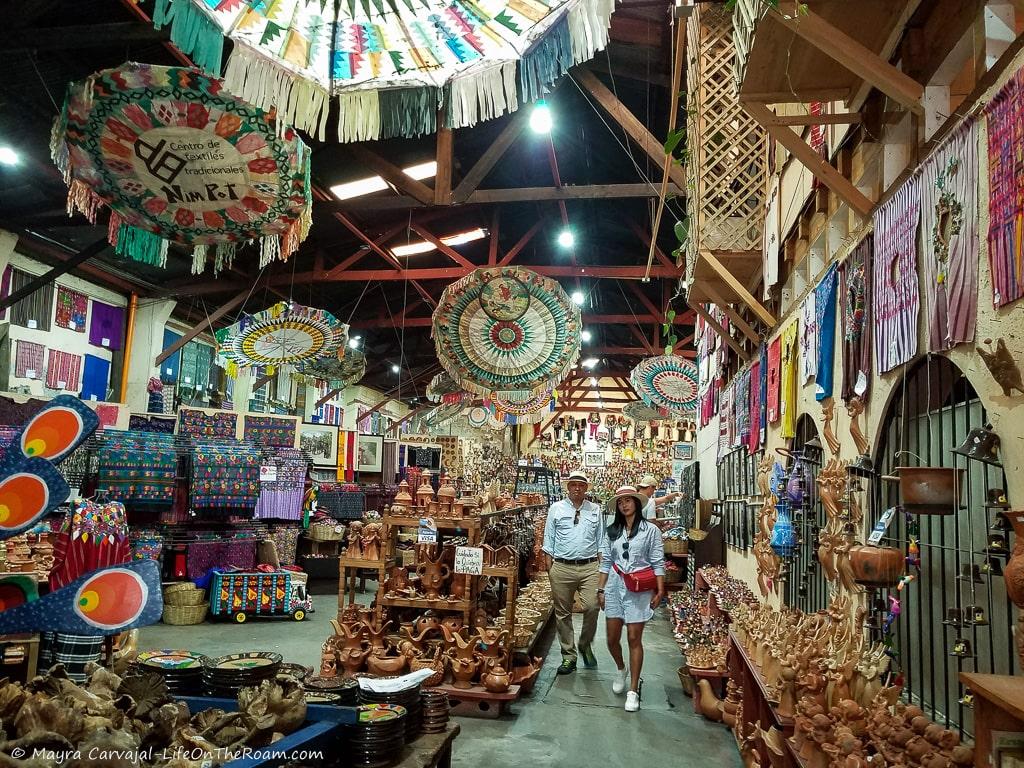
Colour, colour, colour, and an infinity of geometric patterns combining them all.
Textiles are the masterpieces of Guatemalan artists. You’ll see them handweaving their creations in the many lovely patios inside cafés and hotels across Antigua.
You can also visit artisan markets and specialty stores like Nim Po’t Textiles. Most souvenir stores (except for museum stores, I love museum stores) are tourist traps with tacky Made in China stuff and I avoid them like the plague, but this one is totally worth visiting.
They bring handmade items from different villages in Guatemala. Not only textiles, but pottery, woodcarvings, jewelry, and other artwork.
If you want to see a sample of artwork from Guatemalan artisans from around the country visit www.nimpotexport.com
5a Ave. Norte, #29
Learn About the History of Chocolate (and Have Some) at ChocoMuseo

Chocolate goes back several centuries to a time when privileged early Mayans enjoyed it as a spicy drink in sacred ceremonies.
In this exhibit, you can learn more about how it went from an offering to the gods to a product mere mortals can enjoy while you wander in this big store with all things chocolate.
In addition to chocolate bars, you’ll find cacao liqueur with different flavours -cardamom, chili, coffee-, oats with chocolate, cacao tea, and other cacao products.
Take it even further and play chocolatier for one day by signing up for a workshop to make your own chocolate.
You’ll also find a handicraft store and artisans working on their textiles around the bright and sunny central patio café with plants and flowers everywhere.
4a Calle Oriente #8
See the Art Exhibits and Relax in the Cloisters at the Cooperación Española Cultural Center
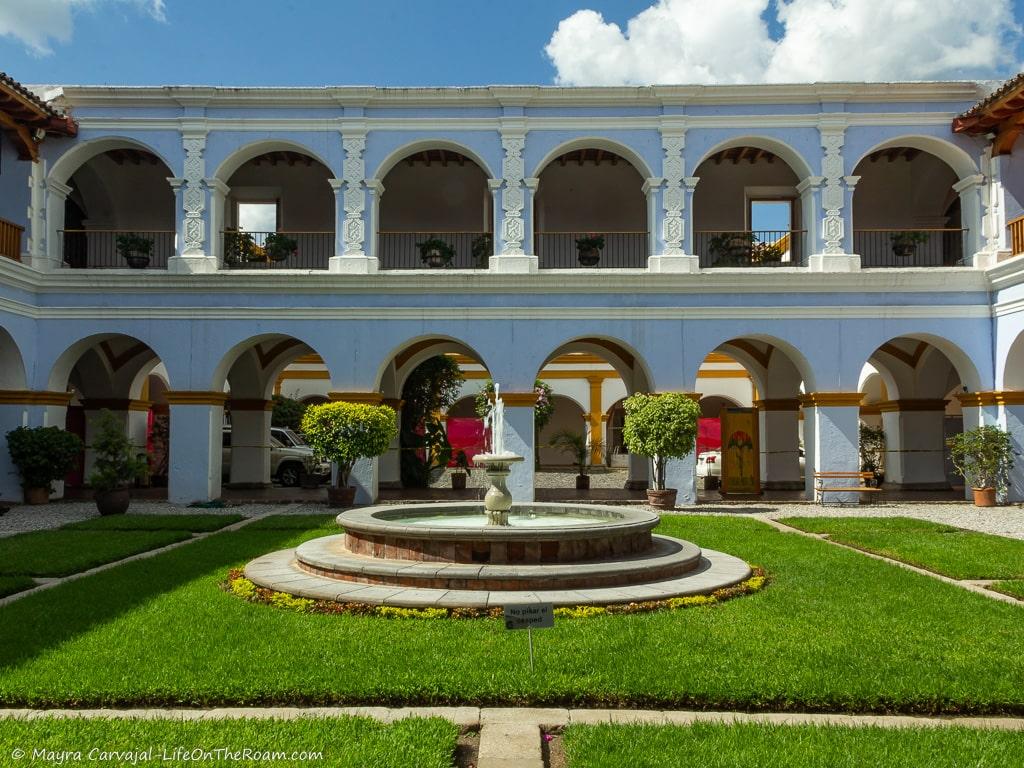
Stop by this cultural centre to see the art exhibits displayed across four halls (I saw a multimedia art installation and an extensive collection of exquisite vessels from the early Mayan period during our visit). You can also attend concerts, dances, film screenings, and performances.
Beyond the art on display, the venue itself is a treasure, -with three cloisters and large patios.
This was the headquarters of the Old School of the Society of Jesus, an education centre founded in 1582 where Jesuit priests lived and taught philosophy, philology, and other subjects. The site was abandoned after the priests were expelled in 1767. Then several earthquakes took a toll on the structure until a restoration project started in 1996 to house the Spanish Cooperation Center.
It’s a pleasure to walk around the property to spot remains of old murals, relax on the patios listening to the fountains, and see the contrast of the blue sky with the bright colours of the colonnades guarding the cloisters.
There is also a cafe on-site in a beautiful outdoor setting serving Guatemalan and Spanish dishes
6a Ave. Norte, between 3a. and 4a. Calle Poniente; Free admission
Visit a Coffee Farm
Coffee lovers, you’re in the right place. There are coffee farms near Antigua where you can walk around coffee fields, learn about the entire production process, and taste samples of a Guatemalan cup of joe (and chocolate, to sweeten the deal).
A fun and different way to do this is by driving an ATV to a nearby coffee farm and then stopping at Cerro de La Cruz viewpoint for an excellent view of Antigua and Volcano Agua.
Check out this Antigua ATV Coffee Tour, with a 4.9/5 rating based on more than 240 reviews.
Take in the Best View of Antigua from the Hill of the Cross (Cerro de La Cruz)
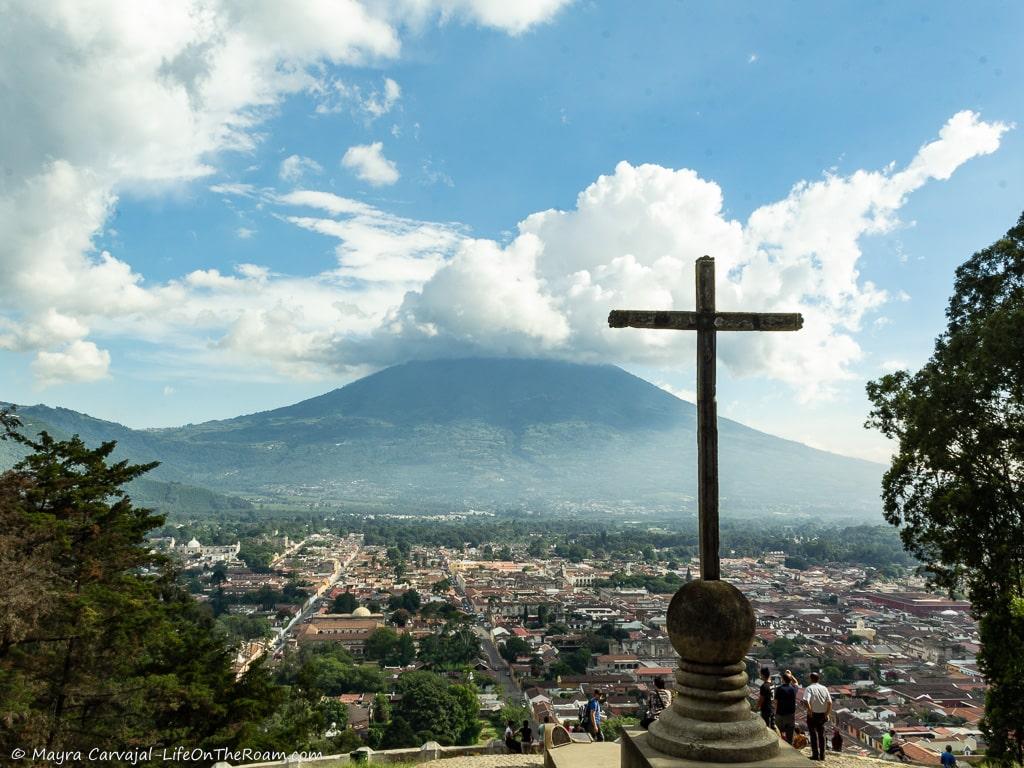
You’ll find one of the best views of Antigua from Mirador de la Cruz, a viewpoint 375 feet above the city that you reach by climbing the steps of the Hill of the Cross, located on the north side. It also happens to be one of the best views of Volcano Agua.
The access to the steps, which takes you through a scenic path among tall trees, is about seven blocks north of Central Park.
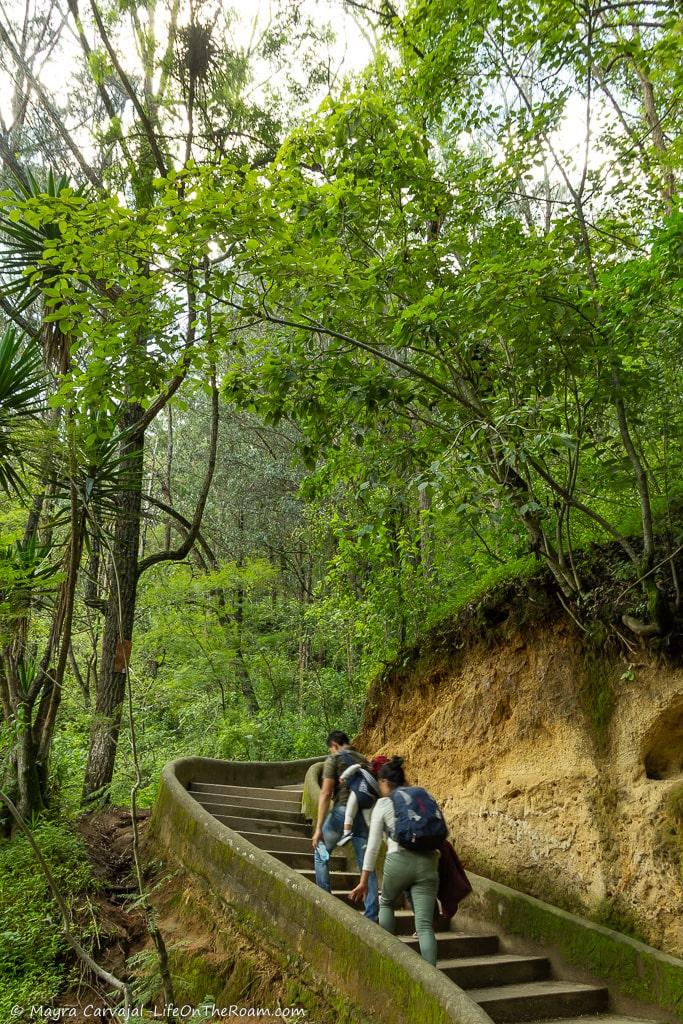
If you don’t feel like walking you can take an Uber to the top and you’ll be only a few steps away from the mirador.
Regarding safety: Antigua is considered a safe city, but robberies have occurred around Hill of the Cross in the past, which led to an increase in police presence (we did see police the two times we went up).
For extra caution, go at the busiest times -normally between 12 and before closing time (they close at 6PM) and on weekends (tons of people!)-, don’t carry any valuables (watch out for pickpocketers), and don’t go by yourself.
See the Archeological Findings and Art Galleries at the Santo Domingo Ex-Convent
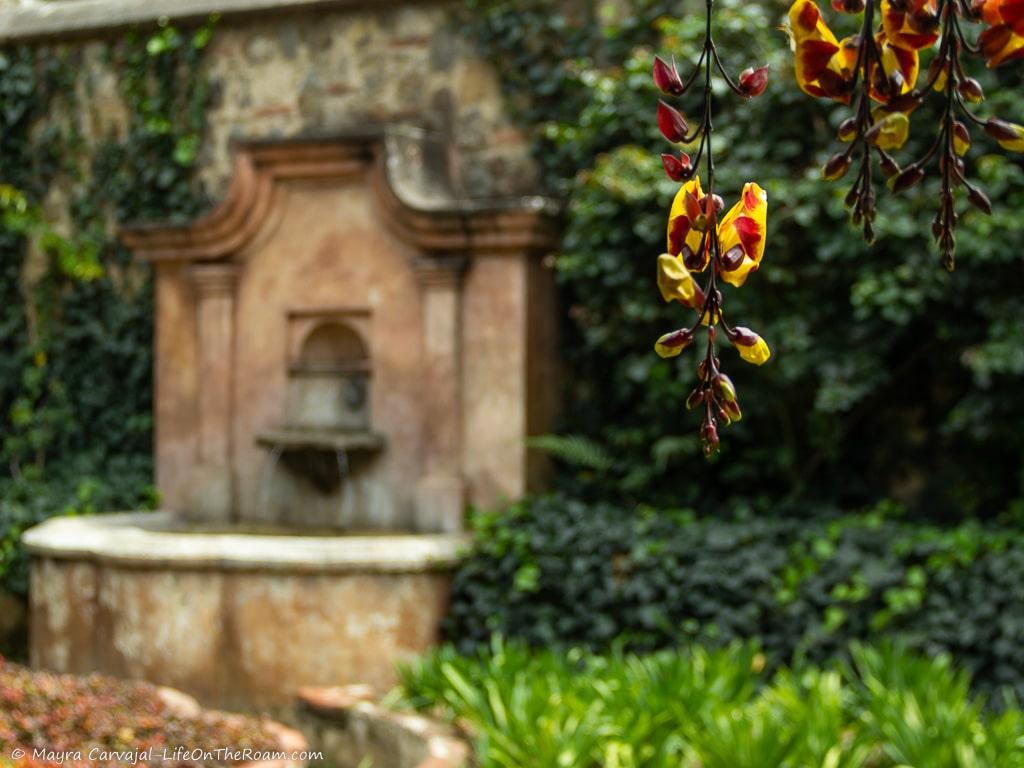
Back in the 17th century, the Santo Domingo convent grew to be one of the largest convents on the continent. Then the infamous Santa Marta earthquake happened in 1773 and nearly flattened the place.
But a project to repurpose the ruins into a hotel (Casa Santo Domingo) kicked off in 1989 and gave birth to one of the most beautiful spaces in Antigua.
The hotel has two art galleries with temporary exhibits and an impressive display of woodcarvings from the 16th to the 18th century, with some polychromed pieces. You can also see findings from archeological excavations consisting of pottery and glass samples from the 18th century used for perfume bottles and potions in the convent infirmary.
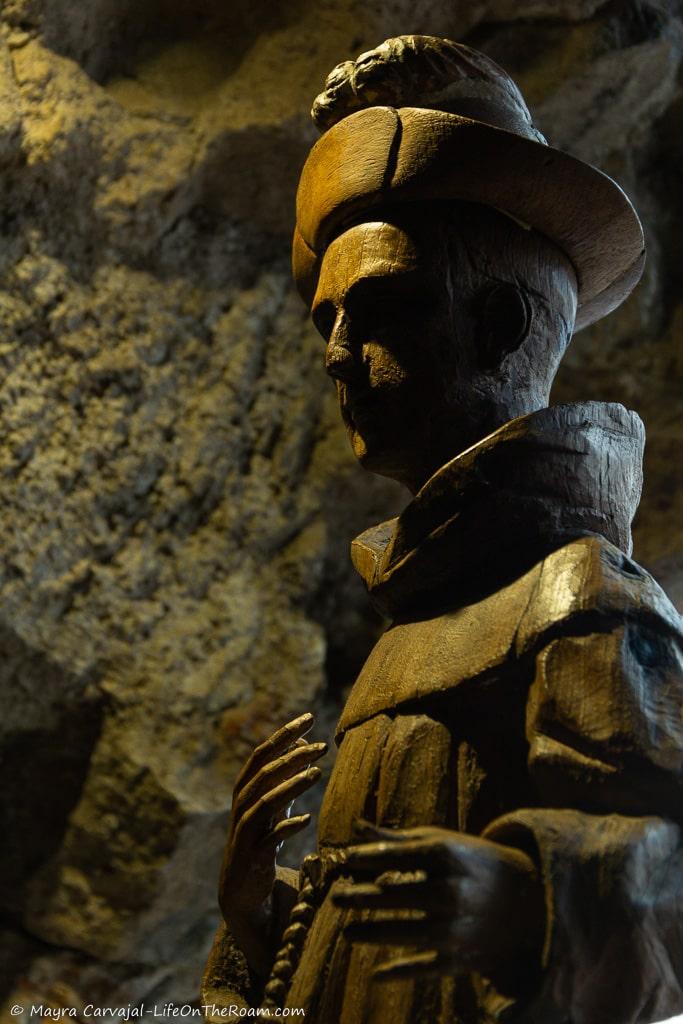
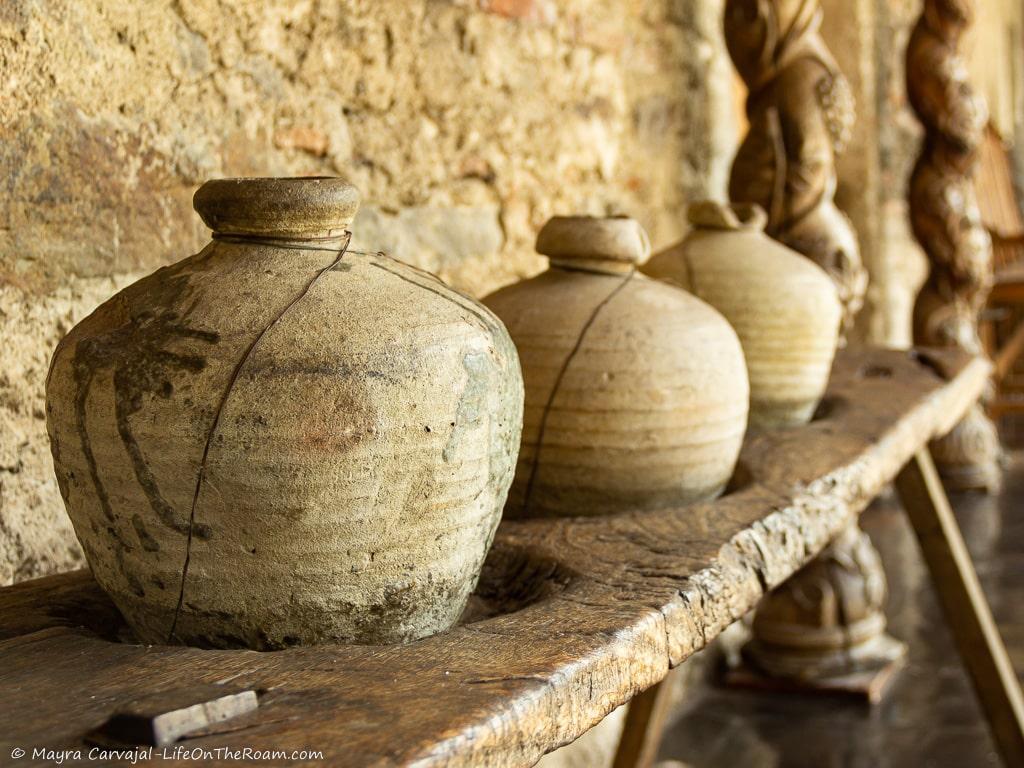
It’s like walking through a big museum with little treasures everywhere, with an added bonus in the form of bountiful gardens, serene ponds, gorgeous fountains, and patios. In some areas, you can see remains of the ruins such as the original kitchen of the convent and the laundry area.
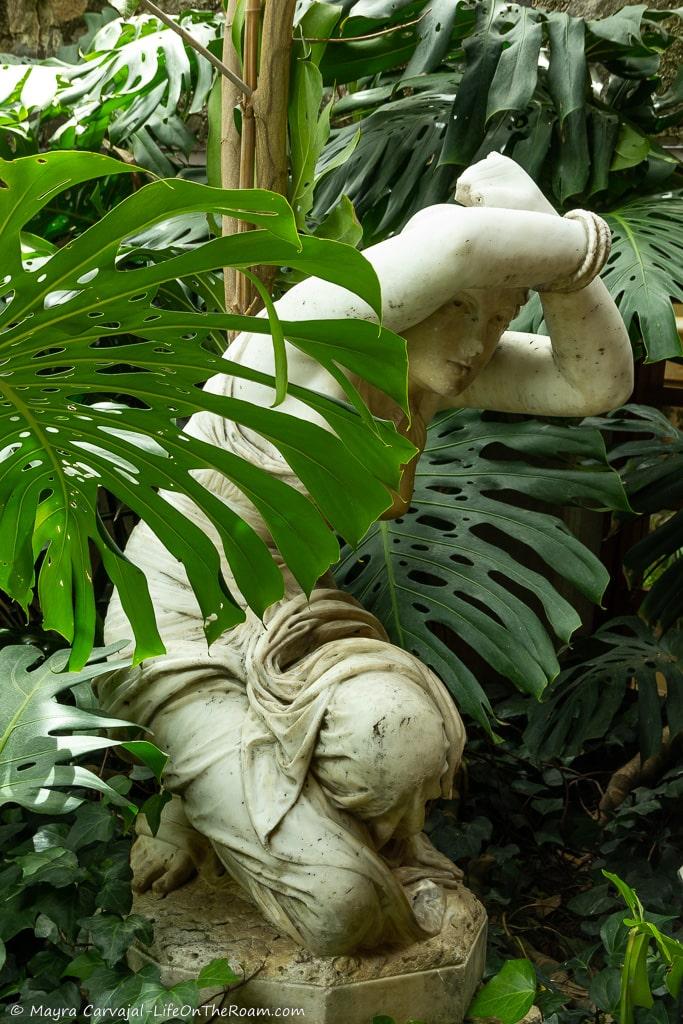

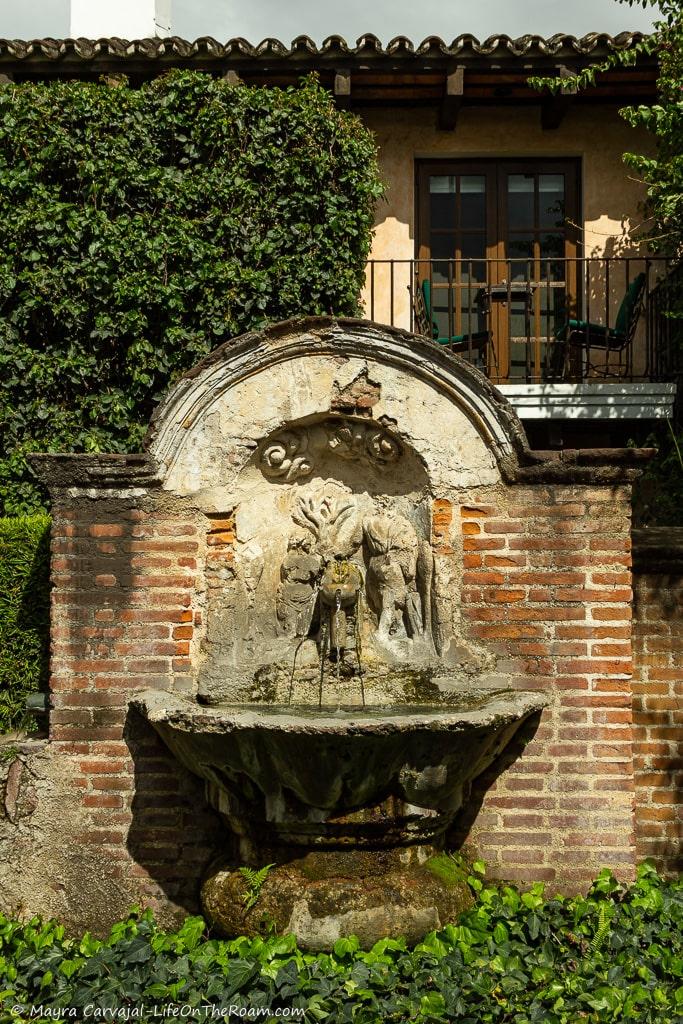
There are several small museums on the property that charge an admission fee unless you stay at Casa Santo Domingo.
You can stumble upon local artisans working on their textiles and selling their handmade products.
If you don’t mind staying in the outskirts of the city (500 metres away) you can also try their glamping accommodations for a revamped outdoor experience: stay in a remodeled airstream, a container, or a cabin. You can find them on the accommodations menu, under the Santo Cielo section.
And their Sunday brunch is one of the best I’ve had in my life.
3a Calle Oriente, #28A
Enjoy the Outdoor Sculptures and the Views from Santo Domingo del Cerro Cultural Park
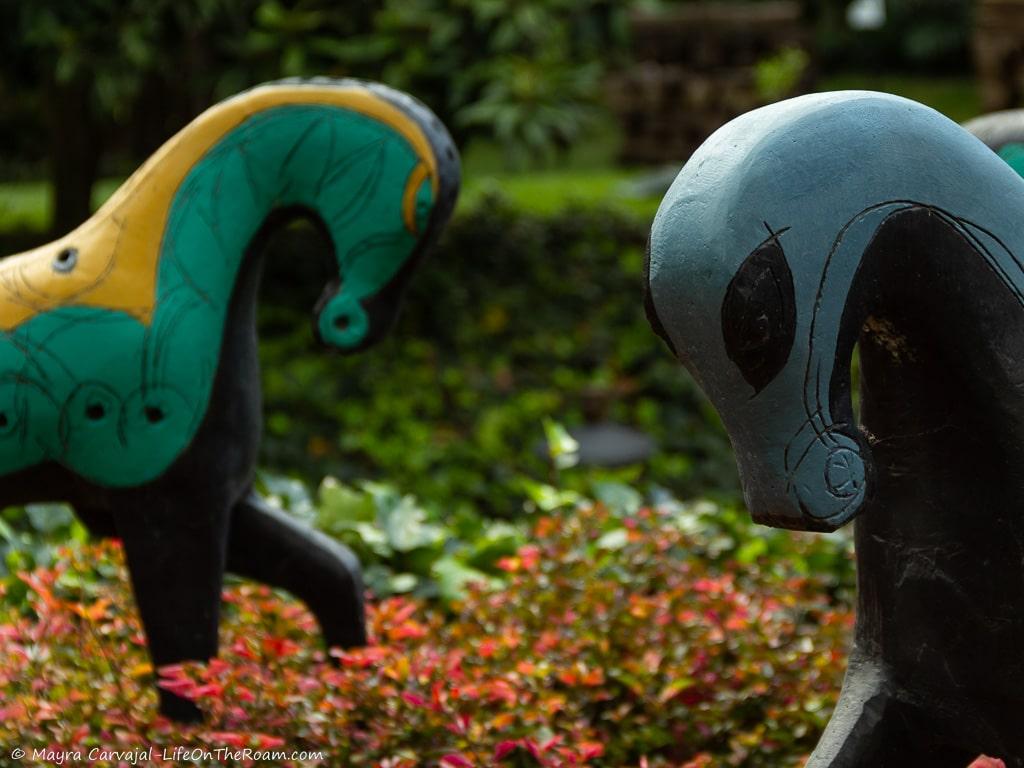
You can easily spend two hours walking around the delightful gardens that frame large sculptures by local artists and seeing the exhibits in the two site museums: the Miguel Angel Asturias and the Efraín Recinos Museum.

The latter was named after an accomplished Guatemalan artist who became a painter, a sculptor, a writer, an illustrator, and a muralist (see below one of his beautiful murals).
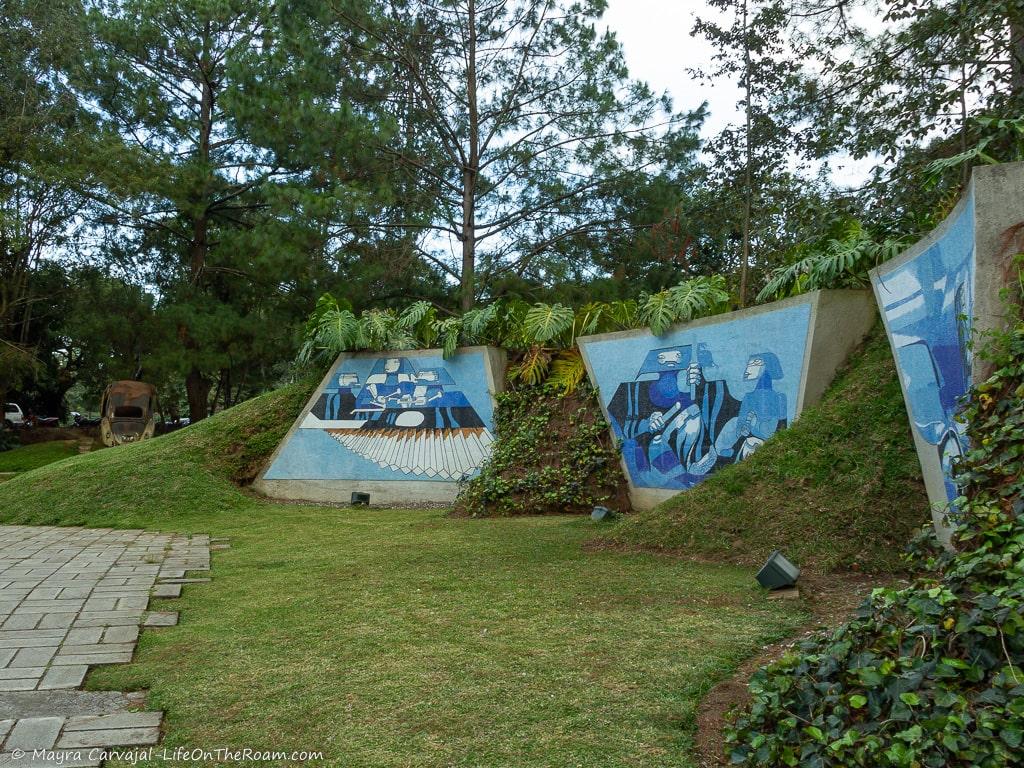
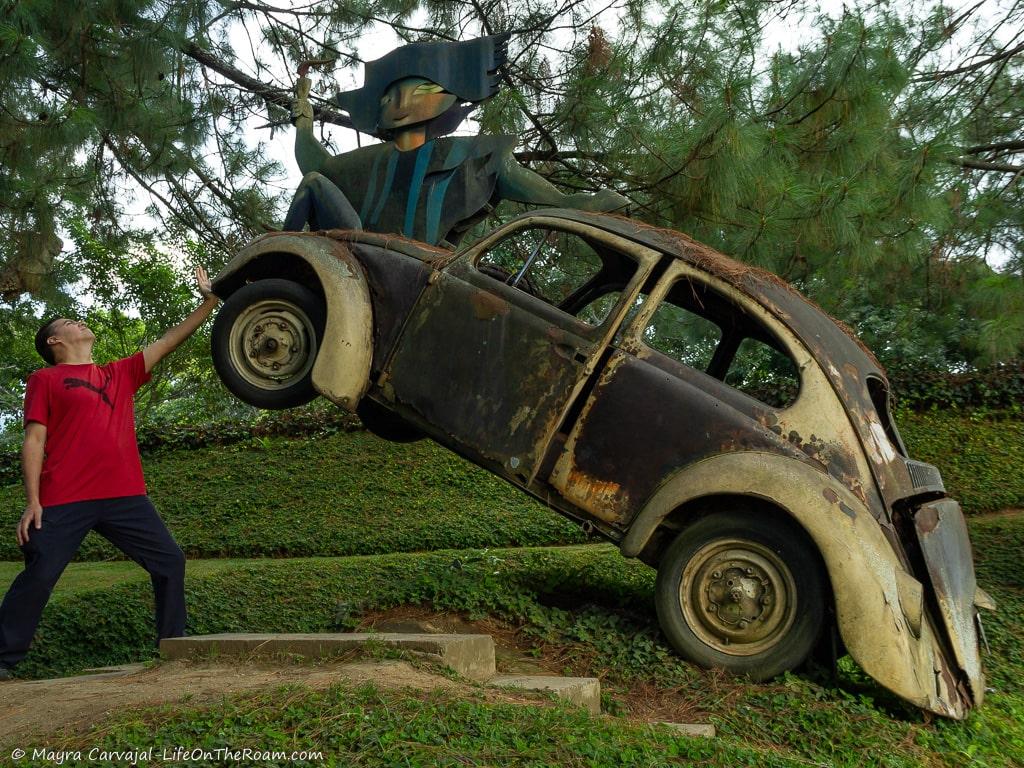
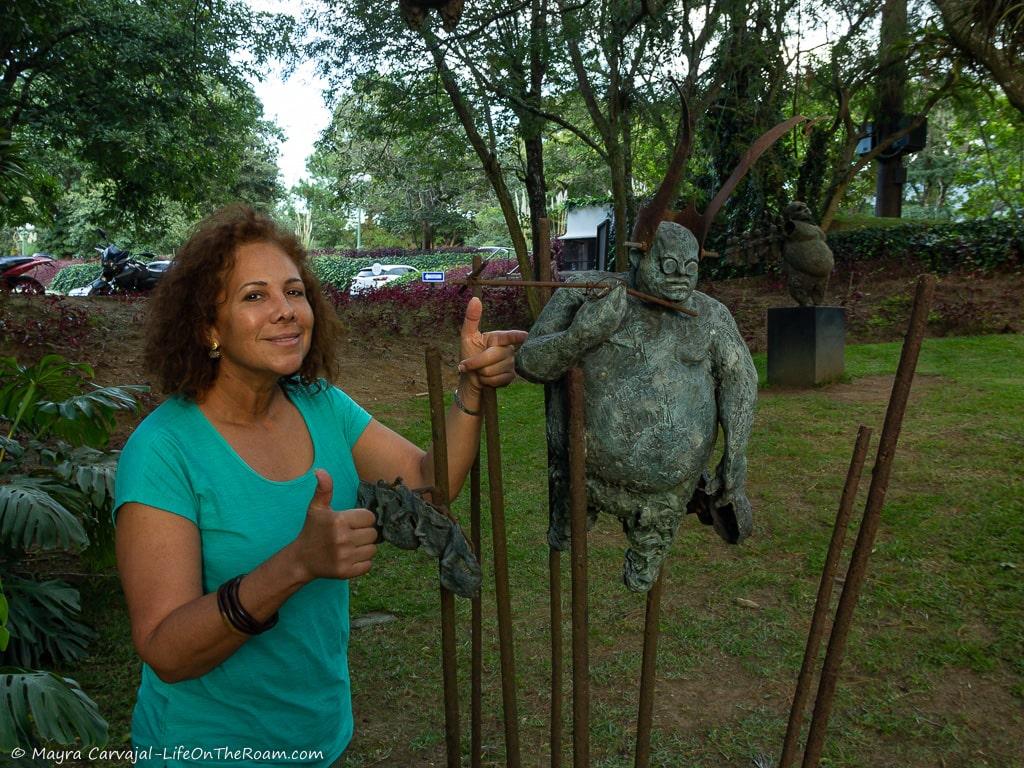
There’s a ziplining circuit (nothing to write home about) and an area where local artisans sell their creations (weekends only).
This is managed by the same people of the Casa Santo Domingo ex-convent, but this location is up in the hills, offering a great view of three volcanos: Agua, Fuego, and Acatenango, and of the city of Antigua.
You can also enjoy the killer view from their popular restaurant (El Tenedor del Cerro) while you have a breakfast buffet, lunch, or dinner.
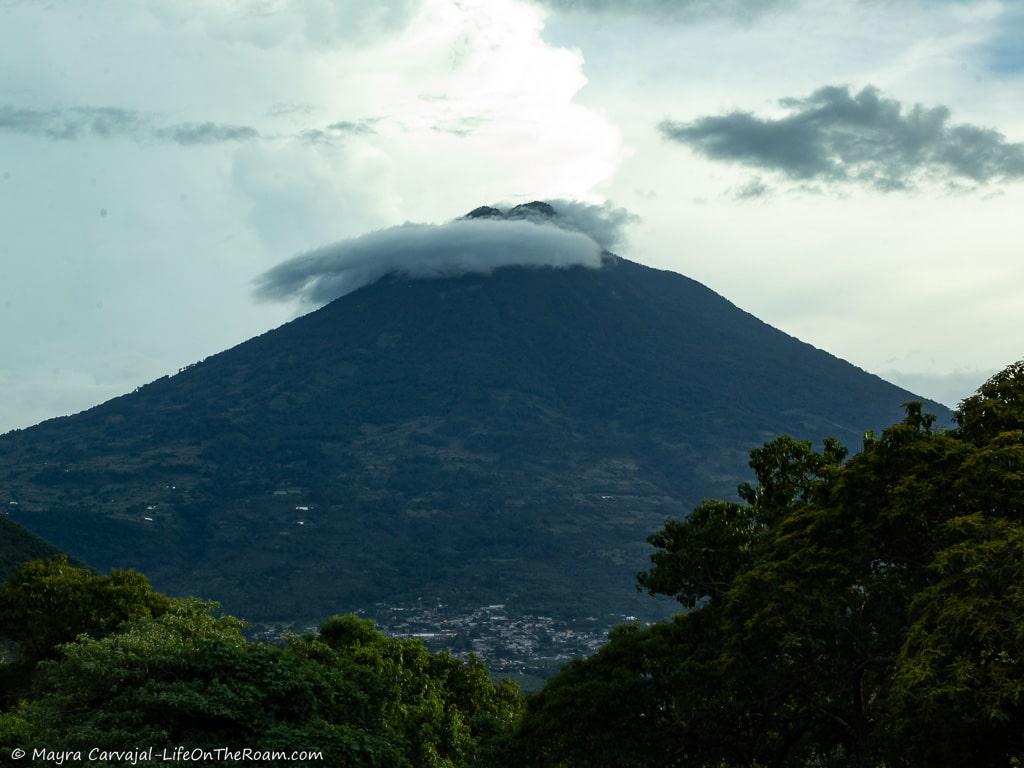
To get here you can take a shuttle from Hotel Casa Santo Domingo
Wander the Streets of Antigua in Search of Architectural Gems
One of the best free things to do in Antigua is wandering the cobblestone streets in search of Baroque-style ruins (with a local twist), old temples with striking ornamentation, restored convents with quaint patios, and fountains.
The preservation of Antigua and its cultural heritage has been an ongoing battle for years, but somehow it has paid off as you feel you’ve been sucked into a book narrating a story from the colonial era.
Here are some gems you’ll see during your visit:
Central Park (Parque Central)
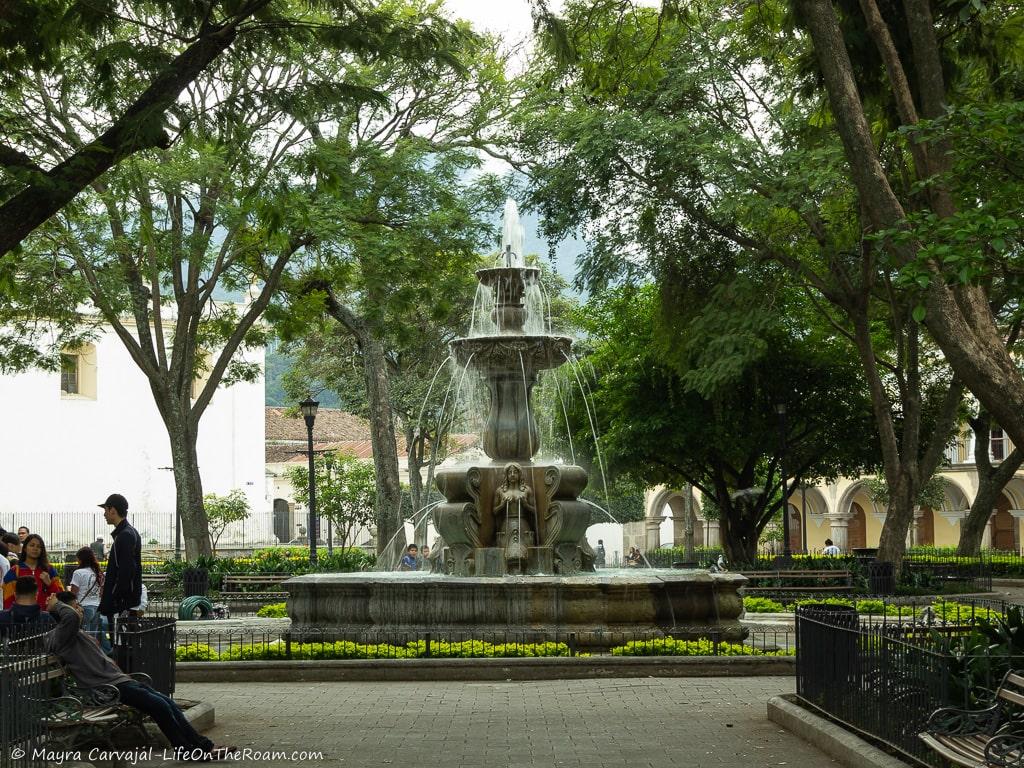
The Italian Renaissance was the source of inspiration for planning the city, resulting in a grid pattern with Central Park (Parque Central or Plaza Mayor) as the central axis. Streets and avenues are named according to their relative position to the park: north (norte) and south (sur) for the avenues (avenidas), and east (oriente) and west (poniente) for the streets (calles).
This is the main square in Antigua for people watching while sitting in a nearby café. The view consists of big trees and the beautiful Mermaid Fountain, with reproductions of the four original water-spewing fish-turned-lady sculptures.
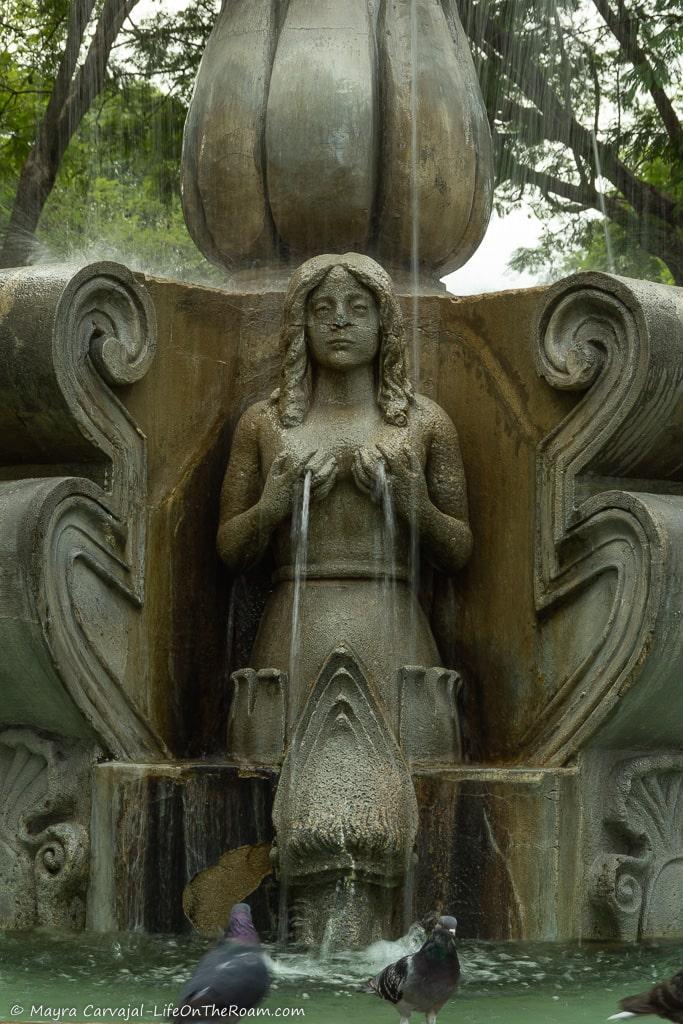
It was designed by Diego de Porras in the 18th century and inspired by the Neptune Fountain in Italy.
San José Cathedral (Old Guatemala Cathedral)
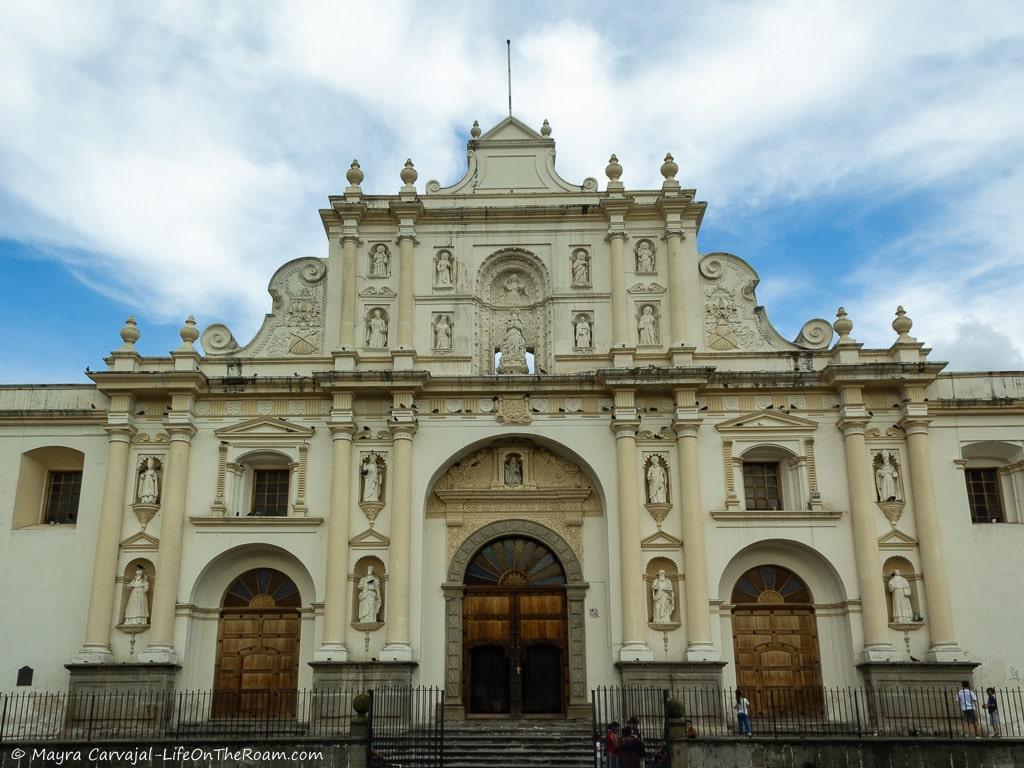
There is nothing left from the original cathedral that was built in 1545. What you see is the “new” building that followed in 1680, which was repaired after the earthquakes of 1717 and 1751. But then a big shake in 1773 damaged it big time and, after the capital was relocated to Guatemala City, the government said Let it go!
But in the 19th century, someone came up with the idea to restore the façade and a small section of the compound. Walk around the block to see the ruins that you can tour for a fee.
San José Cathedral is right across Central Park.
The Temple of the Old School of the Society of Jesus
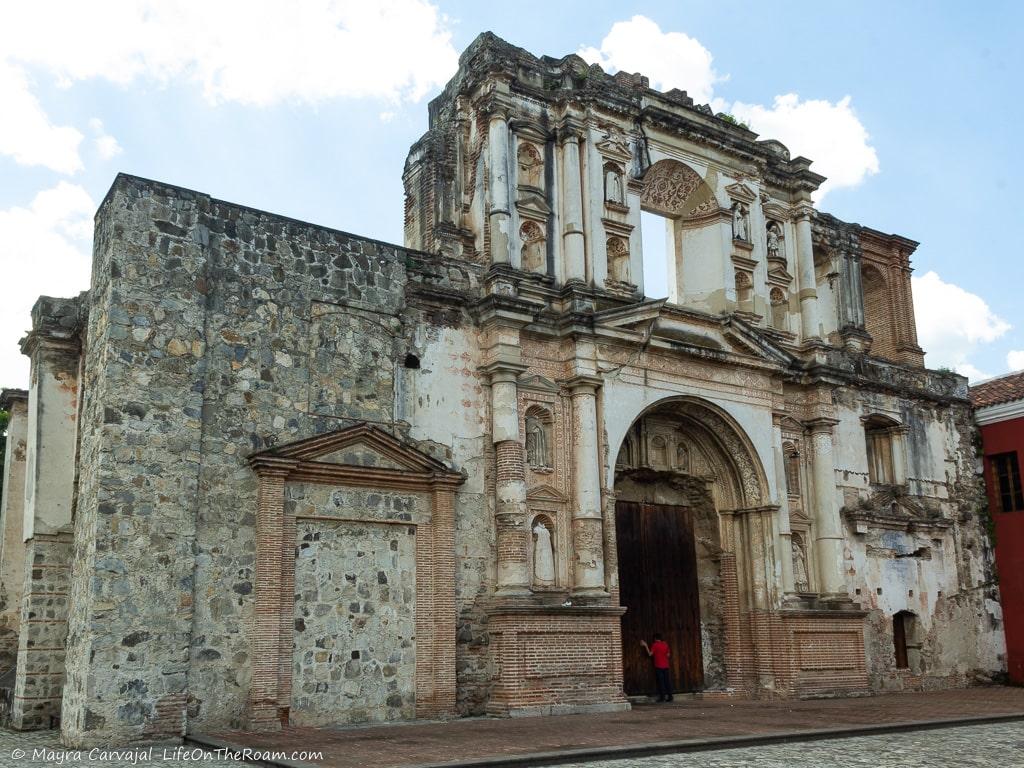
You’ll find these restored ruins from the 17th century and their gorgeous facade next to the Cooperación Española Cultural Center. You can still see statues (most of them headless) in more than half of the niches, and elaborate flowery and geometric motifs in reddish tones. If you love architecture this will bring you joy.
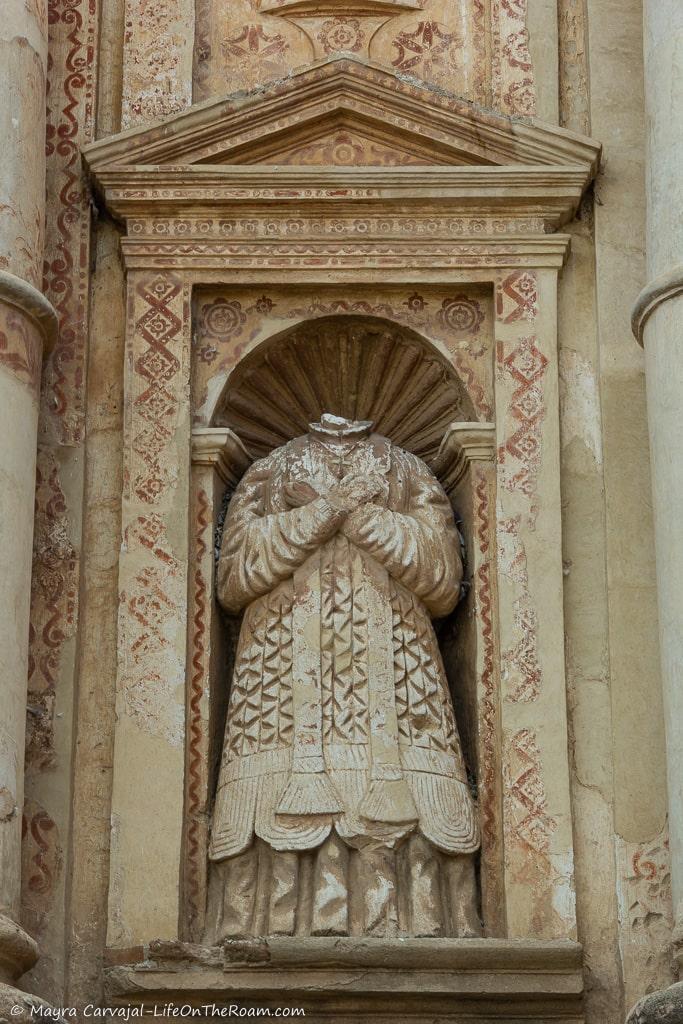

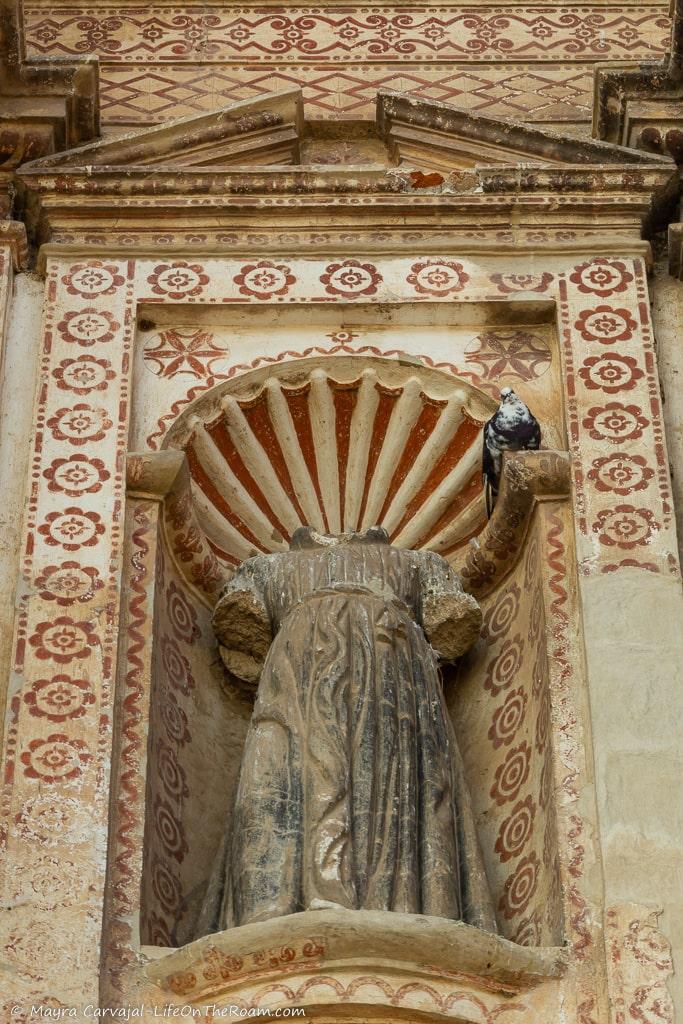
The big square in front is sometimes used for performances. Ask in the cultural centre next door for a calendar of activities.
6a. Ave. Norte, between 3a. and 4a. Calle Poniente
Church of San Pedro Apostol
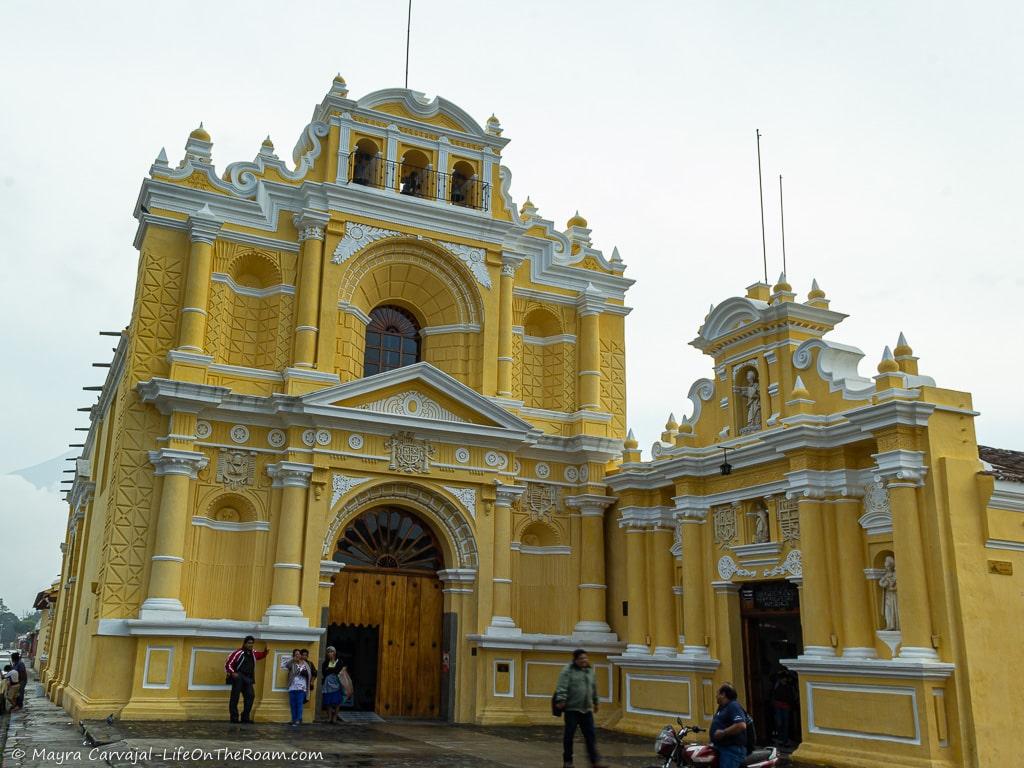
Brighter than a little chicken, this church built in 1654 has the distinction that it has never been flattened by any of the earthquakes (kudos to its engineer!), only requiring restoration of minor damages over the years.
6a Calle Oriente, #20
Church of San Francisco El Grande
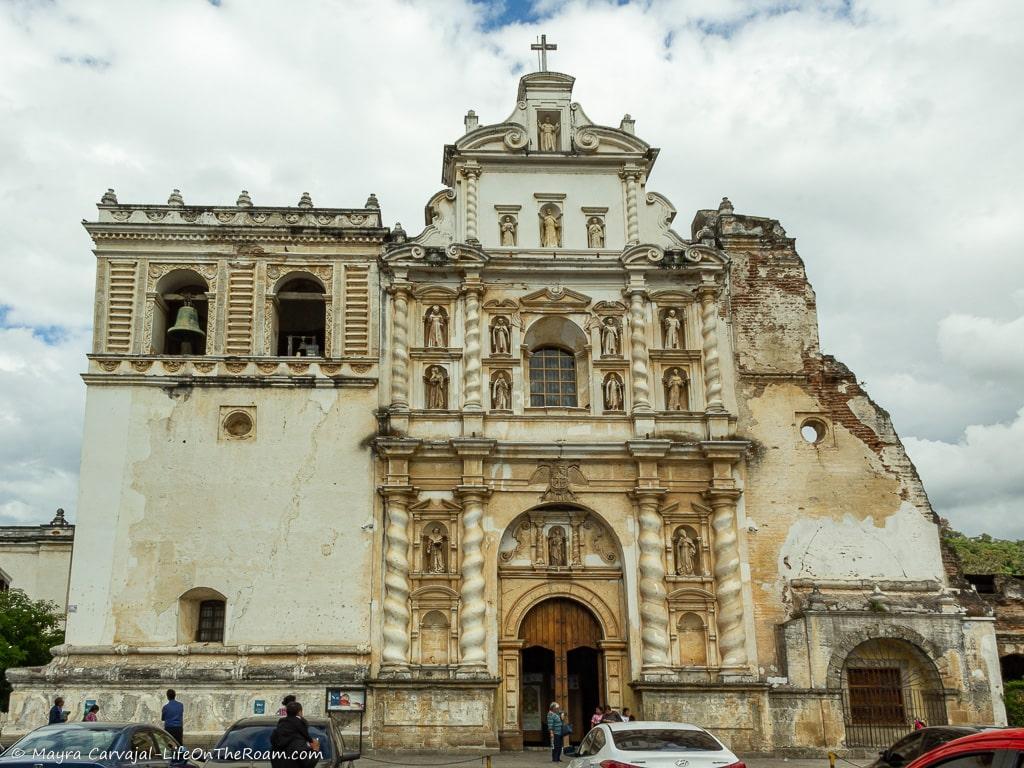
The church dates back to the 16th century with some parts rebuilt and some parts in ruins. The Solomonic columns add a literal twist to the façade.
7a Calle Oriente between C. de Los Pasos and C. del Hermano Pedro
Temple of Santa Teresa de Jesús
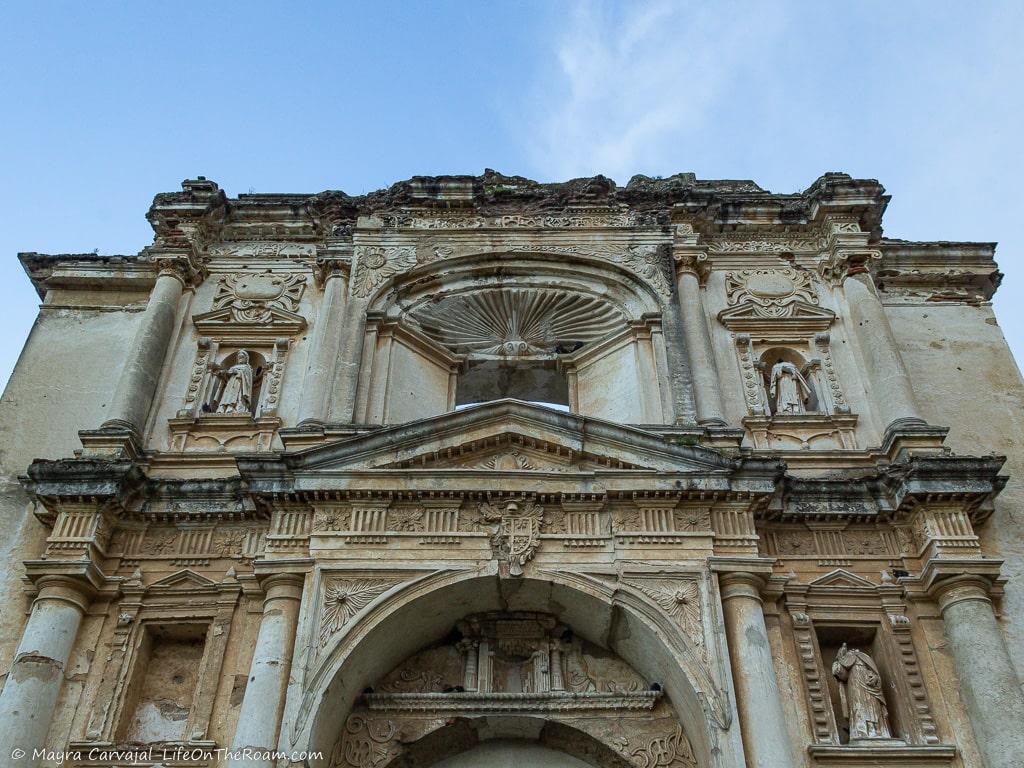
The ruins of this temple were part of the former convent of Carmelitas Descalzas (a nun order), built in 1687.
After the big earthquake of 1773, the nuns moved out and the convent was used as a winery, a patio to dry coffee beans, and a men’s prison before being vacated for restoration.
1a. Calle Oriente and 4a. Ave. Sur
Church of El Carmen (Nuestra Señora de El Carmen)
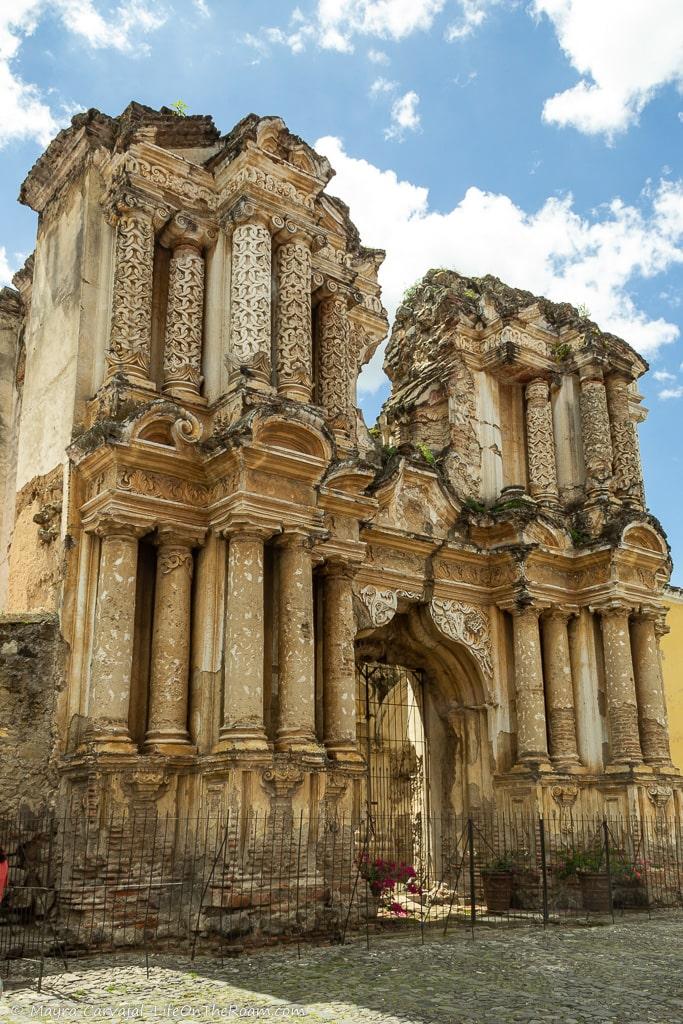
Columns, columns, and more columns, with the upper section showing one of the most beautiful ornamentations you’ll see around.
If you visit during the weekend you’ll find a nice little artisan market on the side.
3a. Ave. Norte (between 2a. and 3a. Calle Oriente)
Church and Convent of La Merced
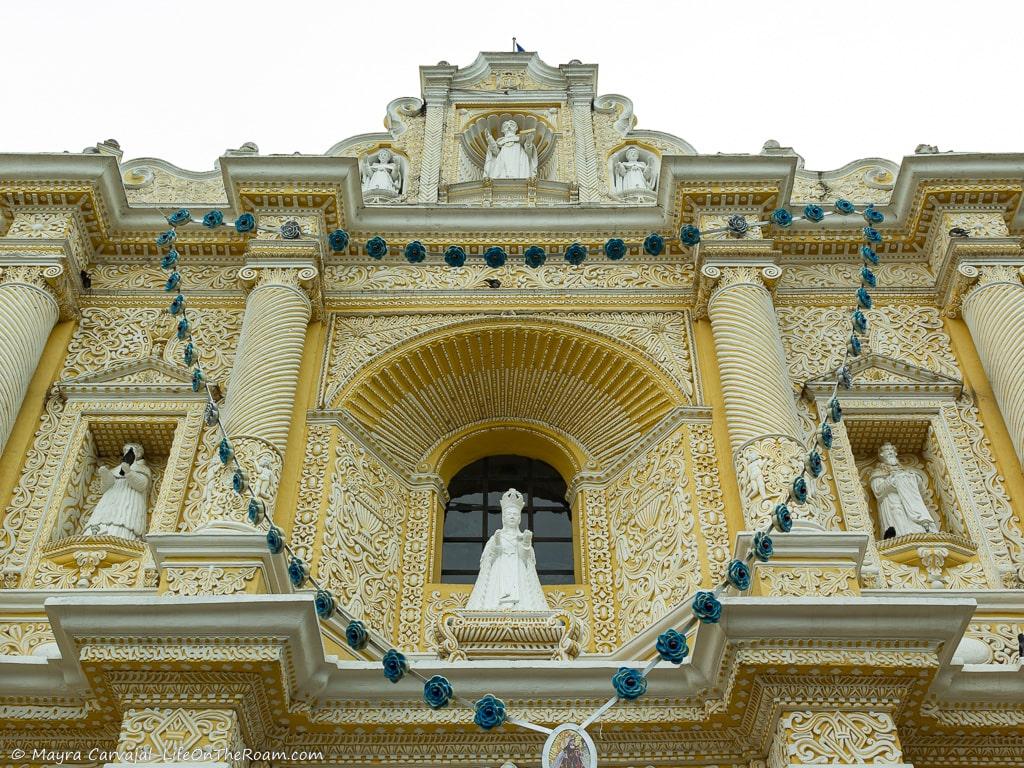
This beautiful ornate façade, one of the best restored in the city with intricate stucco, belongs to the church of La Merced (built in 1767). Behind, you’ll see the ruins of the convent. In front, you’ll see Parque La Merced, where you can find vendors on the weekends selling all sorts of street food.
6a Ave. Norte, #37
Old University of San Carlos (1675)
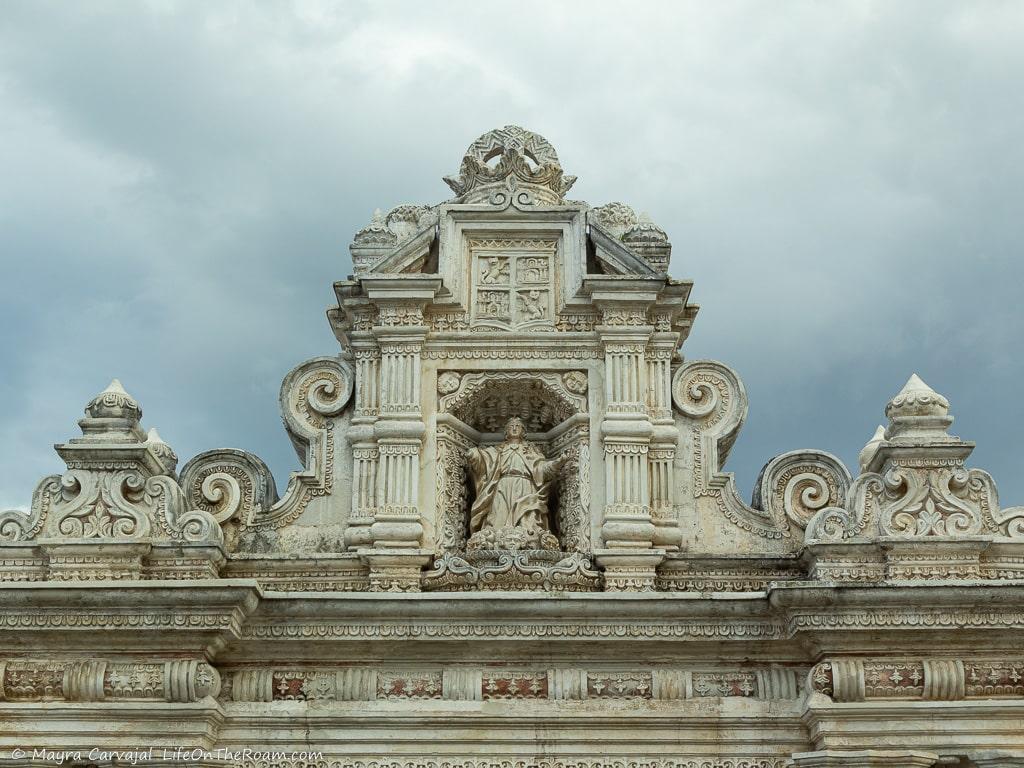
This was the site of the oldest university in Guatemala (built in 1675), and the fourth in the Americas.
Take a Walking Cultural Tour of Antigua
If you’re a history lover and would like to delve into the restoration and preservation works in Antigua and its culture, book a walking tour with Antigua Tours by Elizabeth Bell.
Bell fell in love with the city when she was a teenager and has been living here for more than 40 years.
She has written several books about Antigua and, as an expert in architectural conservation and #1 fan of the place, her efforts to preserve the cultural heritage have been a tour-de-force earning her a gold award from the National Council for the Protection of La Antigua.
Where to Eat in Antigua Guatemala
Antigua is for foodies. You can find an extensive selection of restaurants and cafes for every taste serving local and international food, with many options for vegans and vegetarians. You’ll find many farm-to-table places and a wide selection of baked goods including bread and pastries. And the desserts…Oh my!
Replicate the flavours of Guatemala at home by taking a class at a cooking school and savouring your creations in a terrace overlooking Volcano Agua.
Book this class with a local chef, with more than 175 glowing reviews.
Casa Santo Domingo: Best Sunday Brunch
If you’re around Antigua on a Sunday a fabulous buffet with local and international dishes awaits you at the Hotel Casa Santo Domingo. This is not only food for your stomach but also for your eyes. The hotel is in a former convent from the 17th century with plenty of gardens.
It was so good we came here twice (and wouldn’t hesitate to go back again). 3a Calle Oriente, #28
Cafe Boheme
I miss the absolutely fantastic tarts from this place. They also serve food but I can’t tell you about that because I only had desserts. 5a Calle Poniente, #12B
Centro Comercial La Fuente
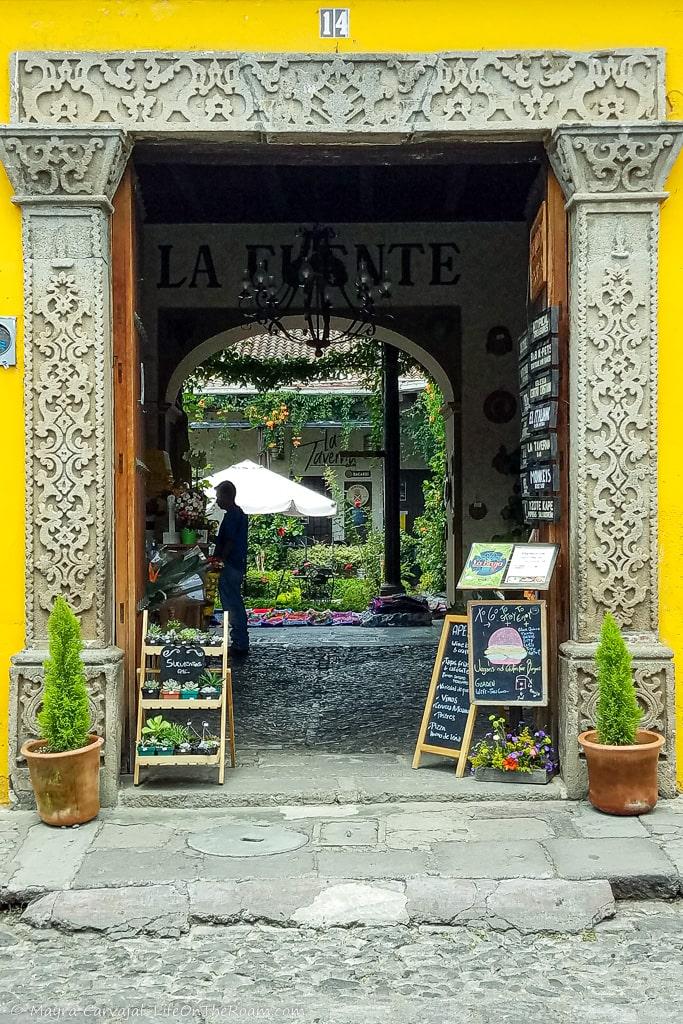
La Fuente Shopping Centre is an example of the gems you can find behind the beautiful doors of former colonial houses: inner patios with fountains and gardens surrounded by lovely cafés, bars, and restaurants (and handicrafts). If only all the food courts could be like this. 4a Calle Oriente, #14
Chermol Restaurant and Beer Garden (Empanadas)
I was very happy with the empanadas argentinas, the beer, and the fun vibe of this place. Avenida El Desengaño, #2
El Sombrerón
The place to go for Guatemalan traditional sweets. You’ll find many made with fruit, some spiked with liqueur (try the canillitas con licor), and you’ll also see sweet bars and other sugary creations such as alfajores and marzipan.
I always had a hard time deciding which ones to try. To help you with that they have some beautiful boxes so you get to try a whole bunch at once. 4a Calle Poniente #11
La Casa del Ron
This casa from the 1700s is the ideal place to try some of the finest rums in Guatemala (and the world). Sip rum cocktails (or enjoy the precious liquid by itself) while having some rum-infused appetizers and let the surroundings take you a couple of centuries back in time 4a Calle Oriente, #22
La Fonda de la Calle Real
This place is great to enjoy traditional Guatemalan food in a beautiful colonial-style house. Best of all, they have vegetarian versions of the dishes (don’t miss the pepián) so vegs don’t miss out on the local feast. I loved it! 5a Ave. Norte, #12
Romeo & Julieta
Excellent option if you’re craving Italian food. We loved the exquisite pasta and the pizza. 4a Calle Oriente, #39
Samsara
Great vegetarian food (with vegan options) served in a zen atmosphere. 6a Calle Poniente, #33
Sobremesa Helados Exóticos
Truly artisanal ice cream prepared in small batches, with inventive flavours (they have come up with 140 flavours so far). One of the best ice creams I’ve had. 4a Calle Oriente, #4
Wachuma (Healthy bowls)
Fantastic vegan restaurant with delicious bowls, burgers, tacos, smoothies, kombucha, and amazing desserts. We kept going back to try the different bowls and desserts and we were never disappointed. 5a Calle Oriente, #12
How to Get to Antigua
The nearest airport is La Aurora International Airport (GUA) in Guatemala City.
Antigua is approximately 45 minutes by car from the capital and you can arrive by shuttle, Uber/taxi, or bus. These are your options:
By shuttle: most hotels offer a shuttle service or have a designated driver to pick up their guests from the airport. It may be the most expensive option, but it’s a flat fee (traffic can get crazy) and it’s the safest. More on that below.
Otherwise, you can book this private shuttle service, with more than 70 (98%) 5-star reviews.
By taxi: only take taxis from the official taxi stand from the airport.
By bus: do NOT take the “chicken bus” (decorated school buses used for public transit) from Guatemala City, it’s not safe. It may be the cheapest option, but robberies have occurred on public transit on this route.
The “chicken bus” is a good option for short trips between Antigua and the nearby towns, but not to travel to/from Guatemala City.
If you must stay in the capital because your flight arrives or depart late at night or at dawn, book a decent hotel located within minutes of the airport, with a shuttle service. Guatemala City is considered dangerous, don’t go out to explore the city by yourself. If you want to do some sightseeing, do it with an established tour agency.
By the way, I asked a local why they call it the “chicken bus” and he said the only ones who do that are the tourists. Locals call it a camión. Don’t go around asking for the “chicken bus”.
Armed with a captivating landscape, dazzling architecture, and a concert of colours and flavours, Antigua is ready to fight for your heart. Take a trip to this fascinating city and be prepared to fall for it.
Share this post with a friend who is planning a trip to Central America or save it to prepare for your own trip.
YOU MAY ALSO WANT TO READ
BOOKING FLIGHTS AND ACCOMMODATIONS
Book your flight without losing your shirt
We check Momondo to find great deals to book our flights. Also, check Great Escape: it combines the listings from Expedia, Kiwi, Kayak, (and Skyscanner on the premium service) to find the best airfares.
To find a place to stay for less
Booking.com: this site combines everything under the sun. You’ll find hotels, apartments, B&B, hostels, rooms, etc., with all sort of filters to make your search a breeze.
Hotwire: the first site I check when we plan to stay at a hotel for a few nights. You can save anything from 20% to 60%. Use the search filter to find what you want and you’ll end up with three listings that match your criteria. You’ll know which one you’ll get after you book. If you can handle a little bit of uncertainty you can score big savings.
House Sitting: you take care of people’s pets and house for free while staying for free. It’s the closest thing to experiencing a place “like a local”. But it comes with responsibilities… Are you an animal lover? It may become your new way to travel.
To get travel insurance
SafetyWing: travel medical insurance that gives us peace of mind knowing that we’re covered in case of emergency. It’s convenient, affordable, and suitable for digital nomads who spend a long time outside their home country.
Check the full list of travel resources on my Resource Page for more options and savings
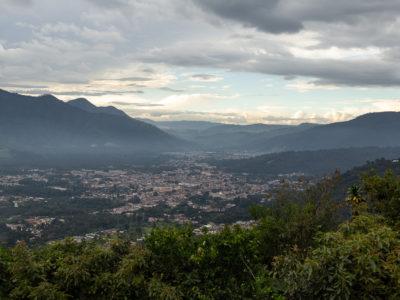
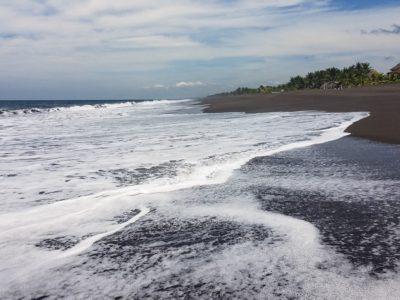
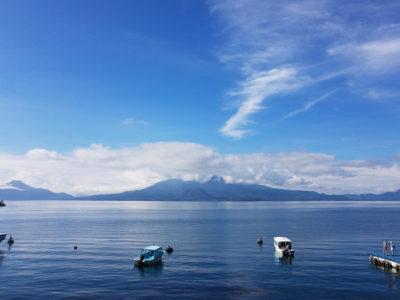
Very detailed article. Makes me want to pack my bags now and Head out to Antigua!
You won’t regret it!
Reading the TOC, you had me at art and chocolate, but reading through there is so much to do here what a wonderful place to wander and get lost in.
Wander and get lost while you have a piece of chocolate. How does that sound? LOL
I’ve never been to Guatemala but it looks like a fun place to visit.
It is! Antigua was special, though.